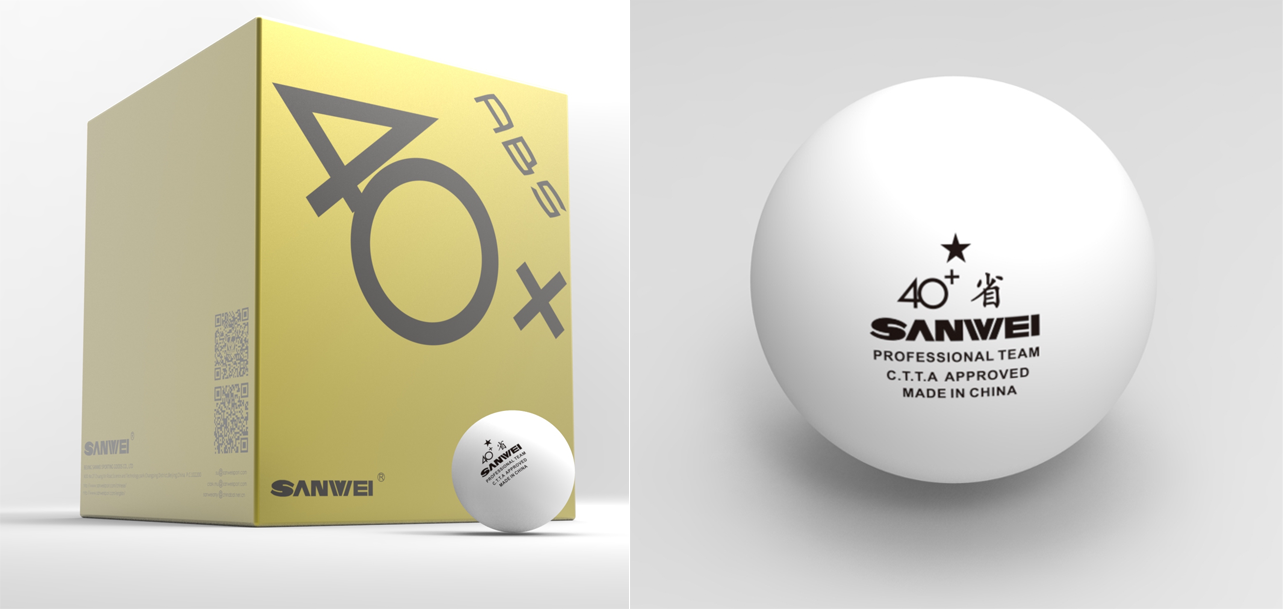Sanwei ABS 1-Star Training balls - detailed review
Wednesday, April 5, 2023
by ThePongProfessor
Good quality training balls are indispensable, be it for use with robots, for multi-ball practice, or as an inexpensive go-to club ball. For example, at our club, where we have up to ten tables, we allocate 8-15 balls per table, with balls being shared among all tables. This keeps the play flowing with minimal interruptions. When I and my practice partner play by ourselves, we typically use 50-80 balls, which ensures a high-intensity work-out. Obviously, we cannot afford to use 3* star balls for this purpose and rely on high-quality, durable, and inexpensive training balls. Over the years, we have used 4-5 different types of training balls, but we are always eager to try out new balls. What follows are our experiences with the Sanwei 40+ ABS 1-star training balls. They can be bought in two different pack sizes, i.e., a pack of 100 or 500 at a very low per-ball cost. I received a pack of 100.

The balls arrived well-protected in a sealed plastic bag, inside a sturdy golden cardboard box. None of the balls were damaged during transport. The information on the box asserts that the balls are made using a new plastic ABS material and that they have been thoroughly tested, exhibiting excellent roundness, bounce, and durability.
The balls are seamed, i.e., two halves have been fused during the production process. The balls have a black logo that lists their one-star status, the 40+ size, the brand name, the country of origin (China) and a C.T.T.A. certification. The balls are ivory colored, hard and rough to the touch, and aren’t covered in excessive amounts of powder. The rough texture of the ball resulted in some transfer of color from the rubbers during game play. I weighed and measured the diameter of 10-12 randomly selected balls and evaluated their roundness by spinning them around their axis. The weights of the balls varied between 2.63 and 2.76 grams according to a high precision scale, averaging 2.71 grams. The balls had maximal diameters between 40.0 and 40.1 mm. Somewhat concerningly, however, I got inconsistent results depending on how I placed the calipers, indicating that many of the balls are not perfectly round. This was supported further by the spin test as several of the balls wobbled. I happened to have an older batch of these Sanwei 40+ ABS 1-star training balls at home and they wobbled less, pointing to batch-to-batch inconsistencies.
My high-level practice partner and I tested these balls during one of our regular practice sessions. We immediately remarked on the relatively hard feeling and crisp sound of these balls, which are typical for ABS balls. We also noted that our topspin shots seemed to travel further than usual. Most notably, we found the bounce of the ball to be very spin dependent. Thus, backspin shots bounced very low, while topspin shots kicked up from the table. Unfortunately, the trajectory and bounce of the balls was inconsistent, lending further credence to my suspicion that the balls are imperfectly round.
In conclusion, the Sanwei ABS 1-star training balls are a cost-effective option for robot and multiball practice, but I would not use them for match play.
Related Links
About The Author
Patrick "ThePongProfessor" Hrdlicka is a table tennis enthusiast, who was introduced to the sport by his parents at the age of six. He progressed to play in the top national cadet and junior leagues in his native Denmark. With college looming, Patrick quit the sport for nearly twenty years. During this hiatus, he obtained a Ph.D.-degree in chemistry and moved to the US as he accepted a chemistry professor position. Since his return to the sport in 2015, he has been combining his analytical skills with his passion for table tennis by testing and writing about a wide range of table tennis equipment. He is a ~2200-USATT-rated left-handed doubles specialist who counts his 2017 US Open (O40 doubles) and 2018 Portland Open (open doubles) titles and Top-16 finish at the 2018 World's Veteran Championships (40-44 year doubles) among his fondest memories. He has a controlled offensive playing style and currently uses a 7-ply limba/ayous based all-wood blade and DHS Hurricane 3 and driving-type short pips in his FH and BH, respectively.
Related Articles
- The Best Outdoor Ping-Pong Table for 2024
- Butterfly Impartial XS and XB Short Pimpled Rubbers - Detailed Review
- Butterfly Dignics 05 - Detailed Review
- Butterfly Viscaria Super ALC Detailed Review – an excellent blade for modern table tennis
- Butterfly Glayzer and Glayzer 09C – Toned-down versions of Dignics 05 and Dignics 09C at a budget-friendly price
- My Ping Pong Buddy (MPPB) Ball Picker V6 - Detailed Review
- Victas Short-Pimpled Rubber Sheets - a comprehensive review of Spinpips D2, VO>102, and Spectol S2
- Falco Long-Term Booster Comparison
- Victas Swat Power – A detailed review
- Sanwei Target National Review: A great and genuine hybrid rubber

